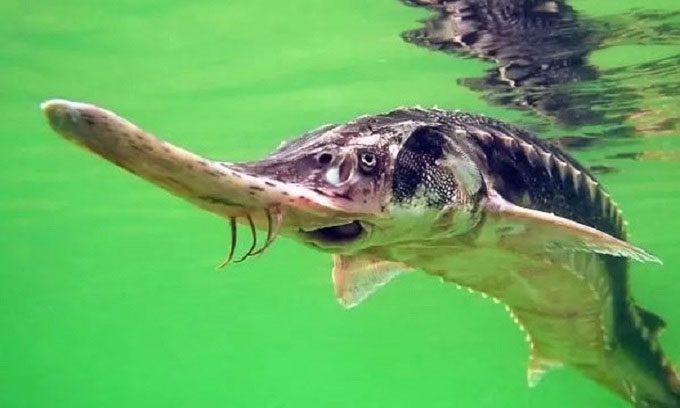The hydropower project on the Rioni River in Georgia could wipe out extremely rare sturgeon species that spawn upstream.
The Namakhvani Hydropower Project was approved in 2019, with plans to construct two dams on the Rioni River. Supporters, including the Georgian government, claim that the project will enhance energy security by increasing the national electricity output by 15% and stimulate the local economy by providing 1,600 new jobs at the hydropower stations.
Meanwhile, conservation experts are concerned about the fate of wildlife in the Rioni – one of the two rivers in the Black Sea region where sturgeon live. This ancient migratory fish family has largely disappeared from habitats across Eurasia and North America. The two new dams could wipe out five critically endangered sturgeon species living in the river, including the Chinese sturgeon, beluga sturgeon, starry sturgeon, Russian sturgeon, and the endemic Colchic sturgeon, by disrupting water flow and preventing successful spawning, according to Fleur Scheele, manager at Fauna and Flora International (FFI).

Starry sturgeon, one of the five critically endangered species that may be affected by the Namakhvani hydropower project. (Photo: Wikipedia).
Özgür Çimenoğlu, environmental manager at Enka Renewables, a branch of Enka, Turkey’s largest construction company and the project contractor, stated that they are implementing measures to minimize the impact on the ecosystem and will monitor sturgeon populations to assess cumulative effects after the hydropower dam becomes operational. However, Çimenoğlu emphasized that it is the government’s responsibility to work with the contractor to consider sturgeon needs and coordinate the river’s flow.
On April 24, after months of opposition from local residents and environmental organizations, Prime Minister Irakli Garibashvili agreed to postpone the dam’s construction for one year to commission and evaluate additional environmental and geological studies and to review the contract details. Conservation experts like Scheele hope this will provide more time to raise awareness about the risks the new hydropower dam poses to sturgeon, which are already struggling for survival.
Having coexisted with dinosaurs on the Eurasian and North American continents, sturgeon evolved over 250 million years ago. Some species can grow over 6 meters long after a century. The demand for caviar has led to the decline of several species, a problem exacerbated by overfishing, pollution, and dam construction. As migratory species swim upstream to spawn, many sturgeon populations across Europe have been devastated by dams. The water released from dams can also wash away their eggs.
In the mid-20th century, two Soviet-era dams were built on the river without fish ladders or bypasses, preventing sturgeon from accessing their ancient migration routes from the Rioni River delta to upstream. A third dam was constructed in 1987, just 113 km from the Black Sea. The Vartsikhe hydropower plant blocks the swimming path to the familiar spawning area of over 80% of the salmon. Within two decades, the salmon population decreased by more than half.
The new project will include two concrete dams, measuring 554m and 265m high, respectively. Although located upstream, their large size will affect the water flow that sturgeon depend on, according to sturgeon expert Radu Suciu, who previously worked at the Danube Delta National Research and Development Institute. Sturgeon rely on seasonal fluctuations in water levels to time their upstream migration in spring. However, the hydropower dam will periodically release water to generate electricity. Significant fluctuations in water levels can affect spawning conditions, causing sturgeon to misjudge the timing of reproduction.
Additionally, the dam will occasionally release large volumes of water to clear accumulated sediment in the reservoir. In one afternoon, such water releases could wash away all the eggs and larvae laid by sturgeon in a season. For most sturgeon species that spawn only once every few years, the impact is devastating. The dam also disrupts the natural flow of nutrients that feed the crustaceans that young sturgeon typically eat, meaning many individuals will starve or fail to develop normally.
Similar dams to the Namakhvani project have led to the extinction of sturgeon in rivers in Turkey, Albania, northern Italy, and many other places. A dam on the Enguri River in Georgia, built in the 1970s, polluted and redirected the water, causing the sturgeon there to disappear.





















































